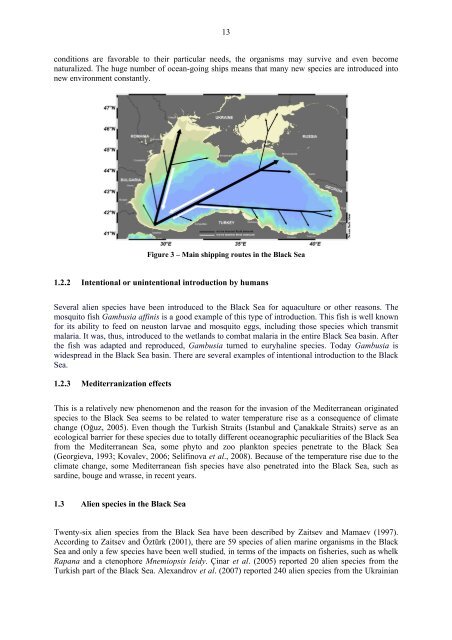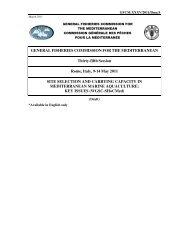Status of alien species in the Mediterranean and Black Sea
Status of alien species in the Mediterranean and Black Sea
Status of alien species in the Mediterranean and Black Sea
You also want an ePaper? Increase the reach of your titles
YUMPU automatically turns print PDFs into web optimized ePapers that Google loves.
13<br />
conditions are favorable to <strong>the</strong>ir particular needs, <strong>the</strong> organisms may survive <strong>and</strong> even become<br />
naturalized. The huge number <strong>of</strong> ocean-go<strong>in</strong>g ships means that many new <strong>species</strong> are <strong>in</strong>troduced <strong>in</strong>to<br />
new environment constantly.<br />
Figure 3 – Ma<strong>in</strong> shipp<strong>in</strong>g routes <strong>in</strong> <strong>the</strong> <strong>Black</strong> <strong>Sea</strong><br />
1.2.2 Intentional or un<strong>in</strong>tentional <strong>in</strong>troduction by humans<br />
Several <strong>alien</strong> <strong>species</strong> have been <strong>in</strong>troduced to <strong>the</strong> <strong>Black</strong> <strong>Sea</strong> for aquaculture or o<strong>the</strong>r reasons. The<br />
mosquito fish Gambusia aff<strong>in</strong>is is a good example <strong>of</strong> this type <strong>of</strong> <strong>in</strong>troduction. This fish is well known<br />
for its ability to feed on neuston larvae <strong>and</strong> mosquito eggs, <strong>in</strong>clud<strong>in</strong>g those <strong>species</strong> which transmit<br />
malaria. It was, thus, <strong>in</strong>troduced to <strong>the</strong> wetl<strong>and</strong>s to combat malaria <strong>in</strong> <strong>the</strong> entire <strong>Black</strong> <strong>Sea</strong> bas<strong>in</strong>. After<br />
<strong>the</strong> fish was adapted <strong>and</strong> reproduced, Gambusia turned to euryhal<strong>in</strong>e <strong>species</strong>. Today Gambusia is<br />
widespread <strong>in</strong> <strong>the</strong> <strong>Black</strong> <strong>Sea</strong> bas<strong>in</strong>. There are several examples <strong>of</strong> <strong>in</strong>tentional <strong>in</strong>troduction to <strong>the</strong> <strong>Black</strong><br />
<strong>Sea</strong>.<br />
1.2.3 Mediterranization effects<br />
This is a relatively new phenomenon <strong>and</strong> <strong>the</strong> reason for <strong>the</strong> <strong>in</strong>vasion <strong>of</strong> <strong>the</strong> <strong>Mediterranean</strong> orig<strong>in</strong>ated<br />
<strong>species</strong> to <strong>the</strong> <strong>Black</strong> <strong>Sea</strong> seems to be related to water temperature rise as a consequence <strong>of</strong> climate<br />
change (Oğuz, 2005). Even though <strong>the</strong> Turkish Straits (Istanbul <strong>and</strong> Çanakkale Straits) serve as an<br />
ecological barrier for <strong>the</strong>se <strong>species</strong> due to totally different oceanographic peculiarities <strong>of</strong> <strong>the</strong> <strong>Black</strong> <strong>Sea</strong><br />
from <strong>the</strong> <strong>Mediterranean</strong> <strong>Sea</strong>, some phyto <strong>and</strong> zoo plankton <strong>species</strong> penetrate to <strong>the</strong> <strong>Black</strong> <strong>Sea</strong><br />
(Georgieva, 1993; Kovalev, 2006; Selif<strong>in</strong>ova et al., 2008). Because <strong>of</strong> <strong>the</strong> temperature rise due to <strong>the</strong><br />
climate change, some <strong>Mediterranean</strong> fish <strong>species</strong> have also penetrated <strong>in</strong>to <strong>the</strong> <strong>Black</strong> <strong>Sea</strong>, such as<br />
sard<strong>in</strong>e, bouge <strong>and</strong> wrasse, <strong>in</strong> recent years.<br />
1.3 Alien <strong>species</strong> <strong>in</strong> <strong>the</strong> <strong>Black</strong> <strong>Sea</strong><br />
Twenty-six <strong>alien</strong> <strong>species</strong> from <strong>the</strong> <strong>Black</strong> <strong>Sea</strong> have been described by Zaitsev <strong>and</strong> Mamaev (1997).<br />
Accord<strong>in</strong>g to Zaitsev <strong>and</strong> Öztürk (2001), <strong>the</strong>re are 59 <strong>species</strong> <strong>of</strong> <strong>alien</strong> mar<strong>in</strong>e organisms <strong>in</strong> <strong>the</strong> <strong>Black</strong><br />
<strong>Sea</strong> <strong>and</strong> only a few <strong>species</strong> have been well studied, <strong>in</strong> terms <strong>of</strong> <strong>the</strong> impacts on fisheries, such as whelk<br />
Rapana <strong>and</strong> a ctenophore Mnemiopsis leidy. Ç<strong>in</strong>ar et al. (2005) reported 20 <strong>alien</strong> <strong>species</strong> from <strong>the</strong><br />
Turkish part <strong>of</strong> <strong>the</strong> <strong>Black</strong> <strong>Sea</strong>. Alex<strong>and</strong>rov et al. (2007) reported 240 <strong>alien</strong> <strong>species</strong> from <strong>the</strong> Ukra<strong>in</strong>ian
















